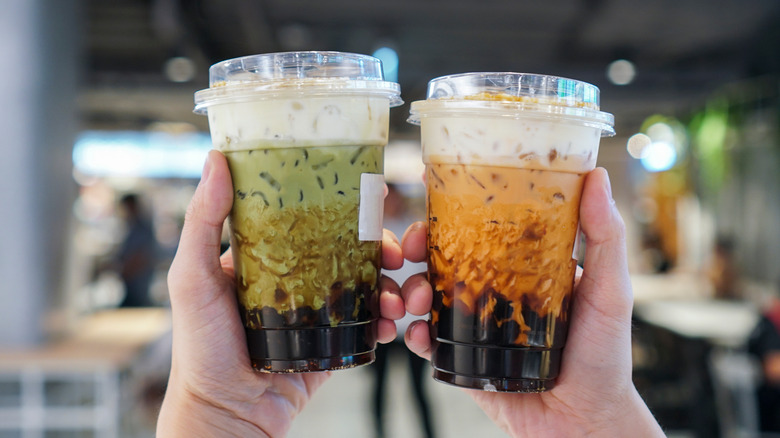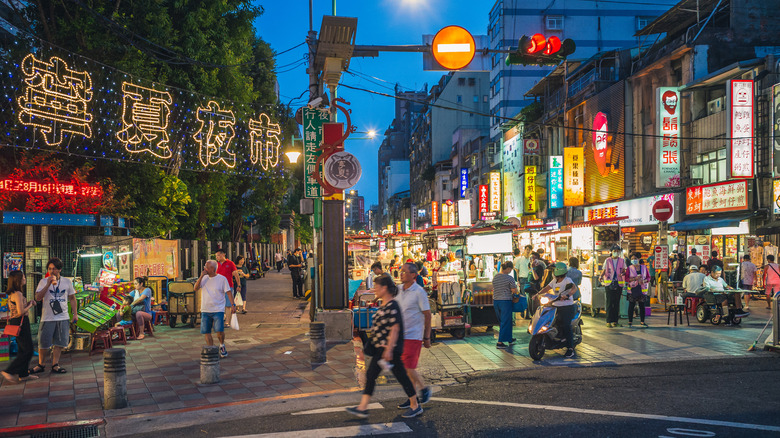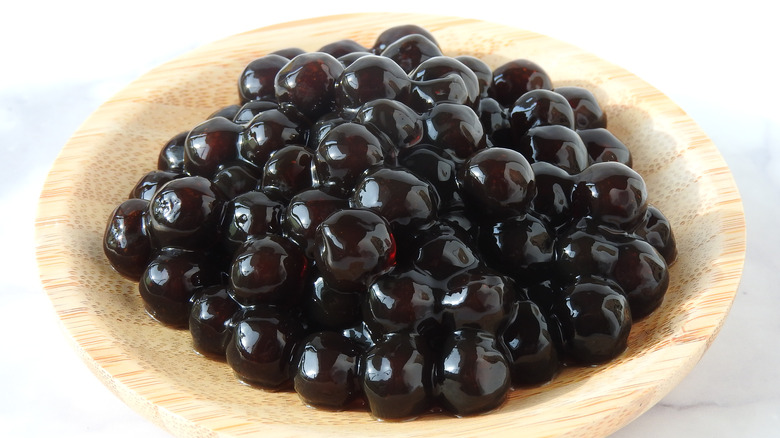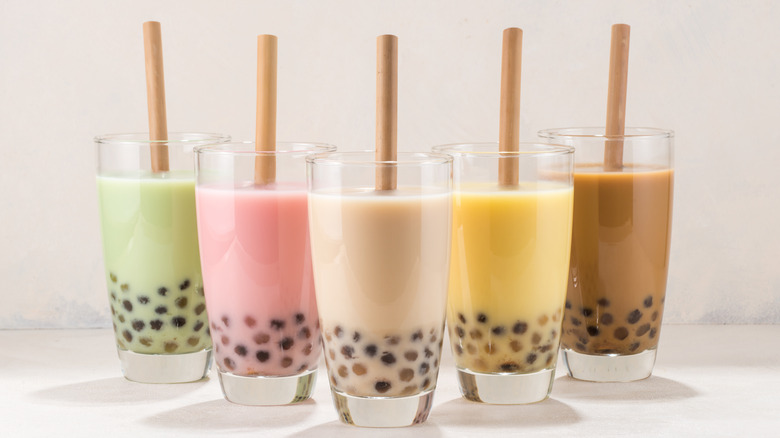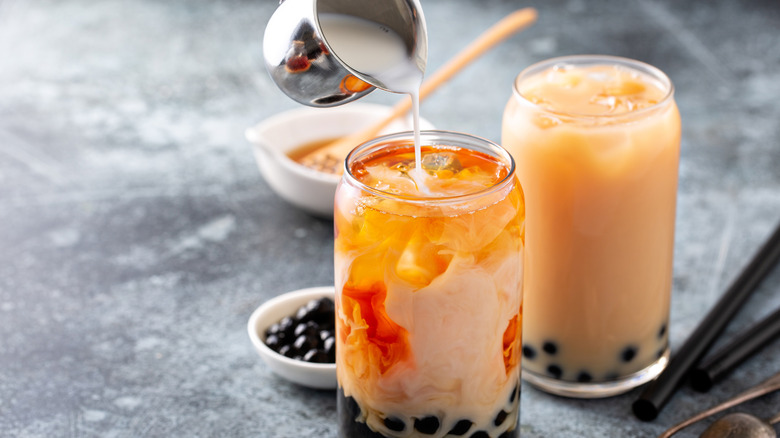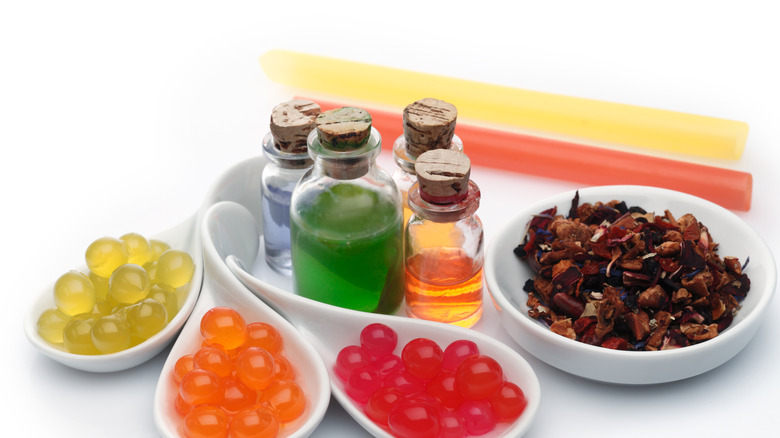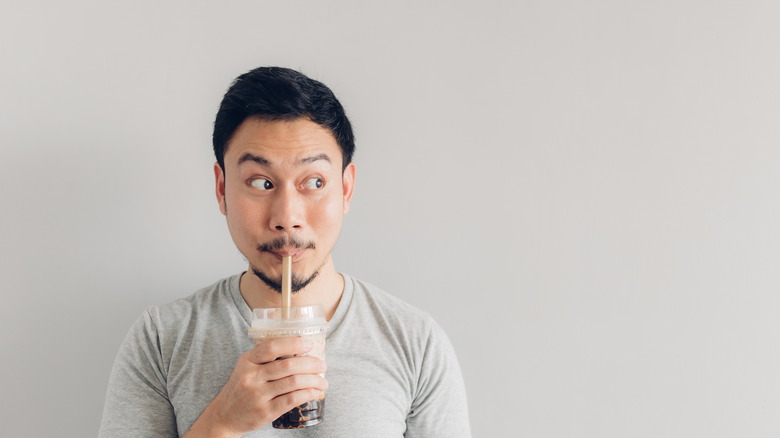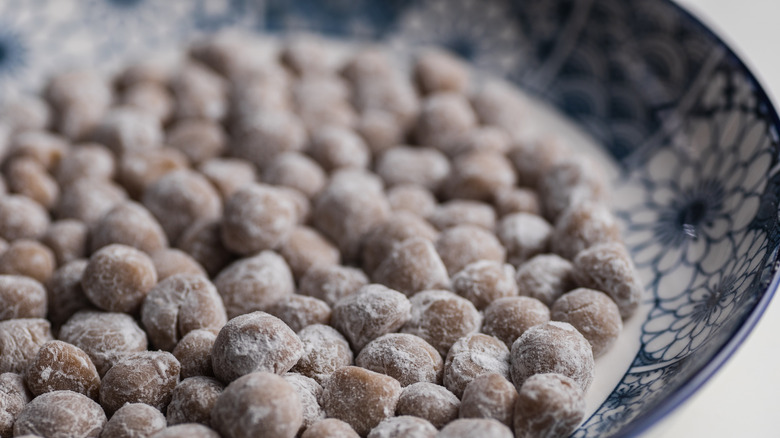What Is Boba Tea And Is It Nutritious?
You may know boba as the fun and — let's be real — aesthetically pleasing drink all over social media. Boba tea may be trending these days, but it isn't a new beverage. In fact, it's been around for nearly 40 years. Served hot or cold, other common names for this drink include bubble tea, pearl milk tea, or tapioca tea. Frothy, milky, chunky, sweet, all of these words could be used to describe boba tea, but what actually is it?
Originating in Taiwan in the 1980s, boba tea has expanded into a catch-all term for chunky drinks. As Eater describes, even juice with fruity bits can be considered boba tea. However, the most common version of boba tea consists of black tea, milk, and chewy tapioca balls. Confusingly, these balls are also called boba. The beverage is usually served cold with a characteristically wide straw to slurp up the tapioca balls. Everything in a boba tea order can be customized. Drinkers can change the type of tea, milk (or lack thereof), and type of chunky mix-in to create a wide variety of flavors and styles.
This popular mix-and-match drink is on a rapid growth trend. Allied Market Research issued a report in 2020 projecting that the global boba business would go from $2.4 billion in 2019 to $4.3 billion in 2027.
Boba tea history
Two people claim to be the brains behind boba tea (via CNN). In one account, boba tea was born in 1986, when Taiwanese businessman Tu Tsong decided to open a tea shop. Tu was in debt and thought he needed a gimmick. First, he added white tapioca balls to green tea. After some experimenting, he came up with the now-familiar black tapioca balls in milk tea. Thanks to boba, Tu's single tea shop in 1986 has grown to 80, with more franchises abroad.
A different story of the birth of boba has Lin Hsiu Hui, the product manager for a chain of Taiwanese tea shops, playfully dumping tapioca balls into her tea at a staff meeting in 1988. Everyone at the meeting loved it, and soon the customers at the company's shops did, too. The two tea purveyors claiming to be the inventors of boba tried to settle their dispute in court. The court eventually ruled that no single company would hold the rights to boba tea and that anyone could make and sell it.
Hundreds of food vendors at Taiwan's night markets immediately took the boba tea idea and ran with it, according to Food & Wine. Boba shops started catching on in a big way in the U.S. in the 1990s, riding Starbucks' wave of popularity at the time. In the 2000s, boba shops became the centers of Asian youth culture in Los Angeles, a movement whose identity became crystallized in the 2013 music video "Bobalife" (via Eater).
How is boba tea made?
Since tapioca is the most common addition to boba, you may wonder how these little, sweet balls are actually made. The boba is made from tapioca starch that turns into dough when boiled, according to Thrillist.
The dough is then cut and rolled into small balls and boiled again until the balls become the soft and chewy treat found at the bottom of your bubble tea. Per Eater, many places will coat the boba in a brown sugar syrup before adding it to your drink to create the sweet flavor so many customers love.
While the standard base in boba tea is black tea, you don't have to stick to the original all the time. You may also want to try your drink with green, taro, oolong, matcha, or even a fruit-flavored tea.
Traditional boba tea usually includes milk as well, but you can always opt-out of dairy if you prefer more of a standard brewed tea. Still, trying boba with a milk substitute is never off the table if that's your preference as well.
Boba tea flavors
One reason for boba's enduring appeal is the wide variety of options available, according to Bin Chen, founder of the Boba Guys chain (via Food & Wine). "There was always this joy growing up that every time you go to a boba shop, you can try something new," he said. Hundreds of varieties of boba are available, per China Market Advisor. In addition to tapioca balls, boba tea can be filled with grass jelly, almond jelly, egg pudding, and red beans. Instead of milk tea, boba can come as a fruit drink, or even in a salted cheese version. You can even find bubble tea pizza and cheesecakes, according to CNN.
You don't need to feel overwhelmed with all these choices because CNN names the most popular boba tea options. If you've never tried the beverage before, one of these would be a good place to start.
Classic bubble milk tea includes tea, nondairy creamer, sugar, and black tapioca balls.
Brown sugar bubble milk tea substitutes milk for the creamer and brown for regular sugar.
Milk foam bubble green tea adds (you guessed it!) green tea and milk foam to the sugar and black tapioca.
In milk tea pudding, the tapioca balls rest atop a bottom layer of pudding.
Some shops offer a flavored bubble cafe latte with adds tapioca balls to the ever-popular espresso drink.
You can even find cocktails with tapioca balls swimming at the bottom, and bubble tea pizza is made simply by adding tapioca balls as a topping to your favorite pie.
Is boba tea nutritious?
Tapioca pearls have little nutritional value (via Healthline). Consisting of mostly carbohydrates, they may give you quick energy but otherwise won't add won't much value to your diet.
While black tea on its own is virtually calorie-free (via Nutritionix), boba tea is typically loaded with sugar. While milk can add nutrients such as calcium and vitamin D, they aren't as significant as the amounts of sugar and calories in the drink. So, any comparison of the nutritional value of various boba drinks comes down to one thing: calorie count.
How do the various types of boba teas stack up when it comes to calories? How do milk teas and fruit teas compare? We get our numbers from the Sharetea boba chain, which provides detailed nutritional information on its website. Sharetea drinks come big, in 24 ounce cups (via Yelp), so size alone will give the chain's tea options a calorie boost. The following calorie counts assume you get your drink fully sweet; you can ask Sharetea employees to adjust the amount of sugar, per The Smoke Signal.
The lowest-calorie options on the Sharetea menu are the brewed teas, from 186 to 288 calories. Fruit teas are the next step up in calorie levels, ranging from 224 (strawberry tea) to 455 (Hawaii fruit tea). Milk teas vary between 410 and 749 calories. The top of the calorie heap is Sharetea's ice blended drinks. The Oreo ice blended with pearl has 985 calories.
Boba vs. bursting boba
If you're ever in a boba tea store, you may see the option to order "bursting boba" in your drink. While there are similarities in boba and bursting boba — they're both sweet inclusions in the bottom of your drink — they're not really the same thing.
Unlike regular boba, bursting boba, or popping boba as it's called in some places, is not chewy at all. Bursting boba is a juice-filled boba ball that will pop when bitten, according to Fanale Drinks. The exterior is made mostly from a seaweed extract with everything from strawberry, mango, passion fruit, lychee, or kiwi, depending on the vendor, available as a flavor.
Other inclusions include jelly, fruit bits, aloe, and even frozen yogurt, per Spoon University. All of these inclusions can change the flavor and consistency of the drink. Some places may even let you mix and match your inclusions for a unique-to-you drink, but before asking them to throw everything in, it's good to know how they differ from each other.
What does boba taste like?
The tapioca pearls themselves usually don't have that much flavor, according to Eater. They're sweet, but in the beverage itself, most of the flavor is going to come from the tea. However, the tapioca balls are incredibly chewy, making them the most fun part of the drink.
If you opt for bursting boba, you'll likely have a sweet, fruit-flavored ball at the bottom of your drink. Depending on what flavor you choose, the boba will generally taste like the artificial variation of that flavor. If you order strawberry bursting boba, for example, while it may not taste exactly like the actual fruit, it'll taste similar to your favorite strawberry-flavored candy.
Since there are so many ways to make boba, there's no universal answer to what the whole drink tastes like. But going off of the standard recipe, it tastes like a well-balanced sweet black tea latte. While the milk certainly adds a creamy quality, it's not overly thick or dairy-heavy. You should still be able to taste the dark and earthy quality of the black tea mixed with sweetness from the sugar.
Where can I buy boba?
Because of its increasing popularity, there are a growing number of boba tea shops across the country offering various flavors and drinks for people to try. However, if you're looking to make boba at home, there are plenty of options for this as well.
While black tea and milk are easy ingredients to find at the grocery store, the tapioca pearls may be a little harder to source. International grocery stores may carry boba pearls, but the most guaranteed way to get tapioca pearls is usually to order them online and places like Amazon. If you go this route, you'll only have to boil the balls and save time without making the dough or shaping the balls yourself.
If you want to make boba completely from scratch, you'll need to find tapioca flour. Stores like Target carry tapioca starch, although you'll also likely be able to find a version in the baking aisle at your local grocery store. Tapioca starch is commonly placed near gluten-free flours, so this is always a safe place to begin the hunt. Otherwise, similar to the boba pearls, it's fairly easy to order this ingredient online.
